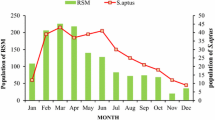Abstract
Common banded awl butterfly, Hasora chromus (Cramer, 1780) (Hesperiidae: Lepidoptera) is a defoliator of Pongamia or Indian beech tree, Millettia pinnata (L). (Fabaceae). The younger instar caterpillar feeds on the newly emerged leaf buds of M. pinnata. The later instar caterpillars move to feed on the older leaves resulting in complete defoliation of the tree. Mass feeding of caterpillars of H. chromus was recorded in the avenue plantation of ICAR-National Bureau of Agricultural Insect Resources (NBAIR) Yelahanka Campus, Bengaluru from March to April 2022. After the completion of the feeding phase of the caterpillars in M. pinnata, the caterpillars usually pupate in the leaves during a normal situation. An unusually high population of caterpillars during this outbreak, they were not pupating on Pongamia for want of sufficient leaves due to severe defoliation. The caterpillars started coming down from Pongamia trees in large numbers like ‘armyworms’ and moving to other plants in the vicinity for pupation. We documented different plant species in the area for pupation by the later instar caterpillars. The caterpillars were found to pupate on 38 different species of plants from 22 different families. The mean number of rolls made by the late instar caterpillar for pupation in different plants ranged between 0.60 to 4.40 per leaf with a mean number of 1.00 to 5.83 pupae per leaf roll. The caterpillars also preferred tiny leaflets of Caesalpinia pulcherrima for pupation by mere webbing together of the leaflets. The mean number of pupae per stem in C. pulcherrima was 38.40 ± 19.58. On average, the mature caterpillar webbed 5.60 leaflets for enclosing their pupae. Predation of the later instar caterpillars during the movement towards the plants by birds (Corvus splendens Vieillot, 1817, Acridotheres tristis L.), solitary wasp Polistes sp., black ant Camponotus compressus (Fabricius, 1787), and red ant Oecophylla smaragdina (Fabricius, 1775) was documented. Documentation of plants preferred for pupation and pupation behavior will help in the conservation of the naturally occurring population of H. chromus.






Similar content being viewed by others
Data Availability
The datasets used and/or analyzed during the current study are available from the corresponding author.
References
Cappuccino N (1993) Mutual use of leaf-shelters by lepidopteran larvae on paper birch. Ecol Ent 18:287–292
Choudhary NL, Chishty N (2020) Effect of habitat loss and anthropogenic activities on butterflies survival: a review. Int J Entomol Res 5(4):94–98
Crawford HS, Jennings DT (1989) Predation by birds on spruce budworm Choristoneura fumiferana: functional, numerical, and total responses. Ecol 70:152–163
Devika Rani D, Jagadesh KS, Jemla Naik D (2020) Biology of the common banded awl, Hasora chromus Cramer (Lepidoptera: Hesperiidae) on Pongamia pinnata at Bengaluru. J pharmacogn Phytochem 9(1):2086–2089
Greeney HF, Walla TR, Lynch RL (2010) Architectural changes in larval leaf shelters of Noctuana haematospila (Lepidoptera: Hesperiidae) between host plant species with different leaf thicknesses. Zoologia 27:65–69
Gupta A, Achterberg CV, Chitrala M (2016) A new species of Crinibracon Quicke (Hymenoptera: Braconidae) parasitic on pupae of Hasora chromus (Cramer) (Lepidoptera: Hesperiidae) from India. Zootaxa 4158(2):281–291
Hawkins BA, Cornell HV, Hochberg ME (1997) Predators, parasitoids, and pathogens as mortality agents in phytophagous insect populations. Ecology 78:2145–2152
Jaleel KA, Jayakrishnan TV, Ghosh SM (2021) Shelter building behaviour of Erionota torus Evans (Hesperiidae: Lepidoptera) caterpillars feeding on banana leaves. Uttar Pradesh J Zool 42(24):1–9
Landres PB, Verner J, Thomas JW (1988) Ecological uses of vertebrate indicator species: a critique. Conserv Biol 2:316–328
Loeffler CC (1996) Caterpillar leaf folding as a defense against predation and dislodgement: staged encounters using Dichomeris (Gelechiidae)larvae on goldenrods. J Lepidop Soc 50:245–260
Loeffler CC (1993) Host plant and habitat effects on behavior, survival, and growth of early instar Dichomeris leuconotella (Lepidoptera: Gelechiidae), leaf-folders on goldenrods. J Res Lepidop 32:53–74
Revathy VS, George M, Narayanankutty TP (2014) Role of recreated habitats in butterfly conservation: a case study at Thenmala, Kerala, India. Int J Trop Insect Sci 34(4):287–295
Schultz CB, Russell C, Wynn L (2008) Restoration, reintroduction, and captive propagation for at-risk butterflies: a review of british and american conservation efforts. Isr J Ecol Evol 54:41–61
Shivalingaswamy TM, Gupta A (2016) Hasora chromus outbreak in Bangalore https://databases.nbair.res.in/insectpests/Hasora-chromus.php
Simberloff D (1998) Flagships, umbrellas, and keystones: is single-species management passe in the landscape era? Biol Conser 83:247–257
Suryanarayan K, Harinath P, Meerabai P, Venkata RM, Venkata RSP (2015) Life cycle of common banded awl Hasora chromus Cramer (Lepidoptera: Rhopalocera: Hesperiidae) from southern Andhra Pradesh. Cibtech J Zool 4(1):45–51
Thomas CD, Bodsworth EJ, Wilson RJ, Simmons AD, Davies ZG, Musche M, Conradt L (2001) Ecological and evolutionary processes at expanding range margins. Nature 411:577–580
Vickery M (2007) Gardens as an aid to the conservation of some butterfly species. Sci Prog 90(4):223–244
Wiklund C, Sille ´n-Tullberg B (1985) Why distasteful butterflies have aposematic larvae and adults, but cryptic pupae: evidence from predation experiments on the monarch and the european swallowtail. Evolution 39:1155–1158
Author information
Authors and Affiliations
Corresponding author
Ethics declarations
Declaration of conflict of interest
The authors hereby declare no conflict of interest in the publication of the manuscript.
Additional information
Publisher’s Note
Springer Nature remains neutral with regard to jurisdictional claims in published maps and institutional affiliations.
Rights and permissions
Springer Nature or its licensor (e.g. a society or other partner) holds exclusive rights to this article under a publishing agreement with the author(s) or other rightsholder(s); author self-archiving of the accepted manuscript version of this article is solely governed by the terms of such publishing agreement and applicable law.
About this article
Cite this article
Udayakumar, A., Chandramanu, K.G.R. & Shivalingaswamy, T.M. A preliminary study of pupation behavior of common banded awl, Hasora chromus (Hesperiidae: Lepidoptera) in an urban farm landscape. Int J Trop Insect Sci 43, 689–702 (2023). https://doi.org/10.1007/s42690-023-00973-0
Received:
Accepted:
Published:
Issue Date:
DOI: https://doi.org/10.1007/s42690-023-00973-0




